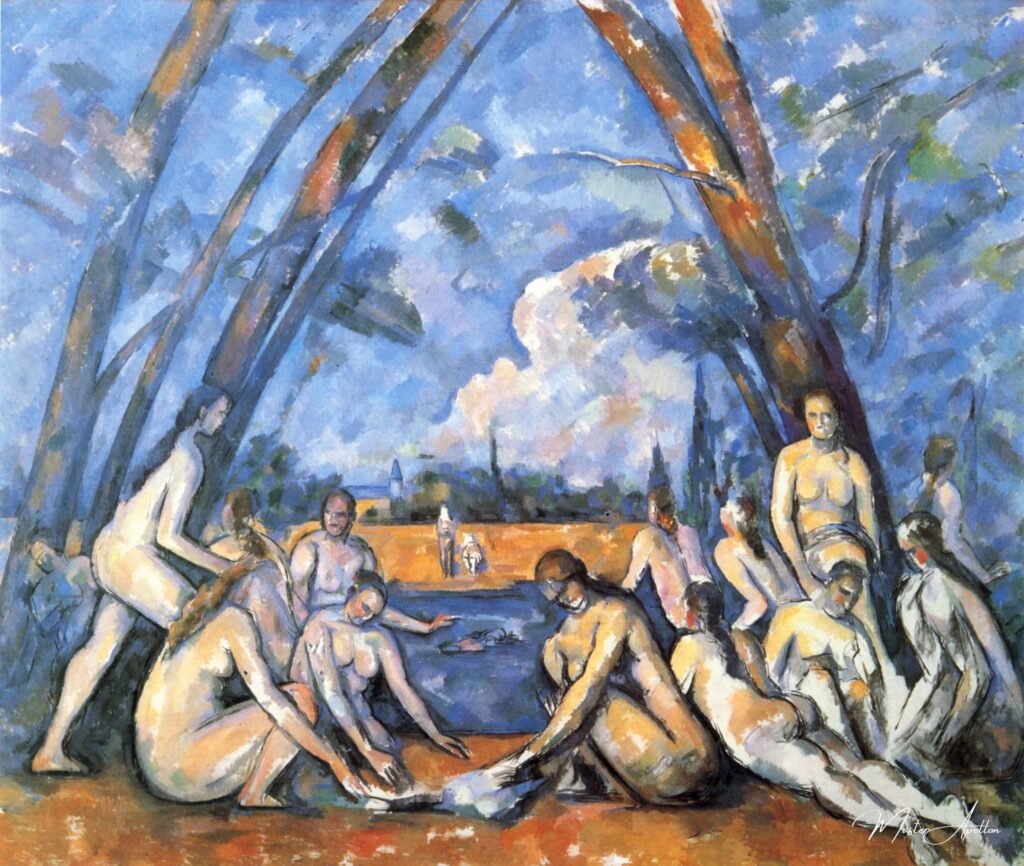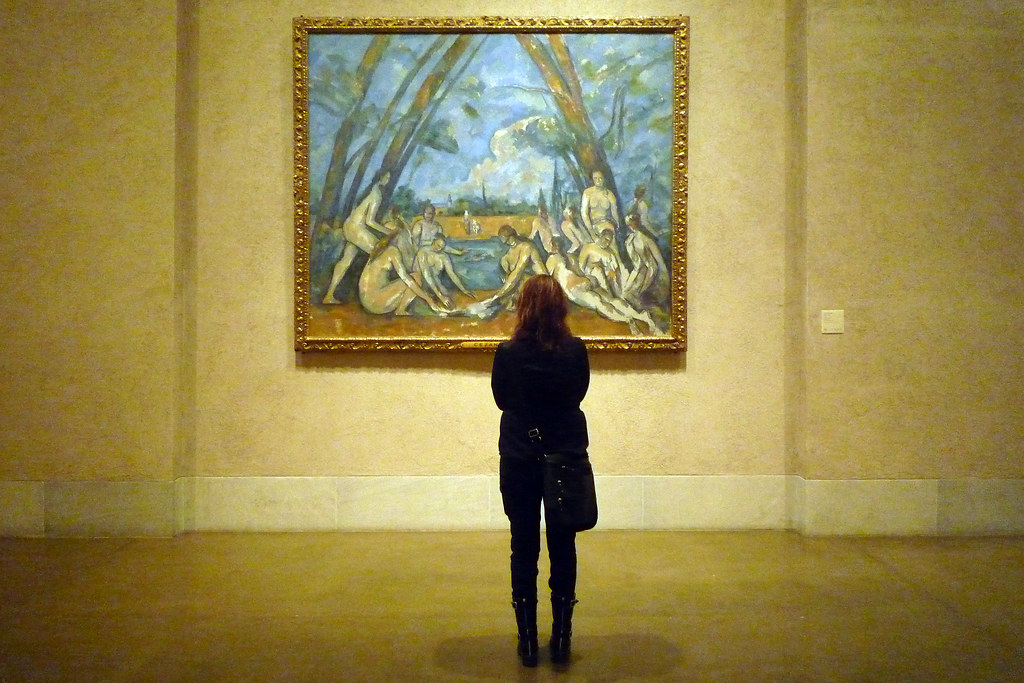Your cart is currently empty!

The Large Bathers – Paul Cézanne
Immerse yourself in the world of art with this extraordinary oil painting reproduction of “The Large Bathers” by Paul Cézanne. This masterpiece effortlessly captures the essence of the original artwork, showcasing stunning precision and an unwavering attention to detail.
Meticulously crafted using only the highest quality materials and expert craftsmanship, this reproduction exudes an air of …
The Paul Cézanne’s The Bathers: A Modern Masterpiece
Introduction
Paul Cézanne’s The Bathers, created between 1898 and 1905, is a monumental work housed in the Philadelphia Museum of Art. This painting represents a pivotal moment in the evolution of modern art, showcasing Cézanne’s innovative techniques and unique vision. The piece stands out for its departure from traditional representations of the nude, as well as its formal innovations that would influence generations of artists to come. This article delves into the themes, significance, and impact of The Bathers, illuminating its role in the trajectory of modern art history.

Overview of The Bathers
Cézanne dedicated seven years to the creation of The Bathers, leaving it unfinished at the time of his death. The painting was first exhibited in 1906, and its impact was immediate. Often referred to as The Large Bathers or Big Bathers to differentiate it from his smaller works, The Bathers is widely regarded as one of Cézanne’s masterpieces. It stands as a testament to his commitment to developing a new artistic language that transcended traditional aesthetics and embraced abstraction.
Main Themes
The Nude in Modern Art
Cézanne’s approach to the nude in The Bathers marks a significant departure from classical ideals. Unlike the idealized figures of the Renaissance or the delicate forms of the Rococo period, Cézanne’s figures are more abstract and less idealized. He challenges the viewer’s expectations by presenting the human form in a way that emphasizes its volumetric nature, allowing the viewer to engage with the figures as entities within a constructed space rather than mere representations of beauty. This unconventional portrayal of the nude positions Cézanne as a forerunner of modern art, influencing artists like Henri Matisse and Pablo Picasso, who would further explore abstraction and the human form.
Formal Innovation
The Bathers exemplifies Cézanne’s groundbreaking approach to composition and form. The painting features a symmetrical arrangement of nude figures set against a lush landscape, creating a palpable tension and density. The triangular composition, formed by the figures, trees, and river, showcases Cézanne’s innovative use of geometric shapes, a hallmark of his work in both still lifes and landscapes. This deliberate structuring of space invites viewers to engage with the painting on multiple levels, encouraging them to decipher the interplay of forms and colors rather than passively consume the imagery.
Cézanne’s use of color and brushstroke also plays a crucial role in the painting’s impact. His technique of applying color in patches, rather than smooth gradations, creates a sense of movement and life within the composition. The juxtaposition of warm and cool colors enhances the depth of the landscape, while also reflecting the emotional resonance of the scene.
Timelessness and Legacy
Cézanne aspired to create art that transcended ephemeral trends, aiming for a timeless quality that would resonate with viewers across generations. This ambition is palpable in The Bathers, where the abstract nudes and unconventional composition challenge the audience to engage with the painting on a deeper, more enduring level. By moving away from the fleeting fads of his time, Cézanne laid the groundwork for future artists to pursue their own visions, defying conventional boundaries in search of timeless artistic expression.
The influence of The Bathers is evident in the works of numerous artists who followed. The likes of Matisse and Picasso would take inspiration from Cézanne’s exploration of form, color, and composition, pushing the boundaries of modern art even further.
Key Facts
Cézanne’s The Bathers is part of a larger series of bather paintings, with other notable versions housed in prestigious institutions such as the Museum of Modern Art in New York City, the National Gallery in London, the Barnes Foundation in Pennsylvania, and the Art Institute of Chicago. The Philadelphia Museum of Art acquired The Bathers in 1937 for $110,000, funded by a trust established by prominent benefactor Joseph E. Widener. While this acquisition was generally celebrated, it also sparked debate regarding the allocation of funds and the societal context surrounding art acquisition.
The first exhibition of The Bathers in 1906 marked a turning point for Cézanne, who was often underappreciated during his lifetime. Art critics and historians would later recognize the significance of this work in the broader narrative of modern art.
Comparisons with Other Iconic Works
The Bathers is frequently compared to Pablo Picasso’s Les Demoiselles d’Avignon, another groundbreaking piece depicting nude women. Both artworks represent a significant departure from traditional representations of the female form and illustrate a turning point in the development of modern art. While Cézanne emphasizes a sense of solidity and geometric structure in his composition, Picasso’s work embodies a more radical fragmentation of the human figure. Together, these paintings exemplify the diverse approaches that artists were taking to redefine the representation of the human form during the early 20th century.
Quotes on The Bathers
Cézanne’s The Bathers has been described as “one of the masterpieces of modern art” and “often considered Cézanne’s finest work.” This sentiment reflects the painting’s enduring appeal and significance within the modern art canon. As noted in the commentary on his work, “With each version of the Bathers, Cézanne moved away from the traditional presentation of paintings, intentionally creating works that would not appeal to the novice viewer.” This intentional distancing from popular trends allowed Cézanne to create a timeless quality in his work that resonates even today. Critics have remarked, “[Cézanne] made the ineptly drawn Bathers a warm evocation of leisurely summer bliss,” capturing the idyllic quality of the scene while acknowledging the artist’s unconventional techniques.
Conclusion
Paul Cézanne’s The Bathers stands as a pivotal work in the history of modern art. It embodies the artist’s innovative approach to composition, his exploration of the nude in a non-traditional manner, and his ambition to create timeless works of art. By challenging classical ideals and employing formal innovations, Cézanne forged a path for future artists to explore new artistic territories. The painting’s lasting influence is seen in the works of countless artists who followed, cementing The Bathers status as a masterpiece of the modern era. Its ability to evoke deep engagement and contemplation continues to resonate with audiences, ensuring its place in the pantheon of art history.
Paul Cézanne
Paul Cézanne was a pioneering French Post-Impressionist painter whose innovative approach to form, color, and composition profoundly influenced the development of modern art, emphasizing the importance of structure and perception in his iconic works.





Leave a Reply